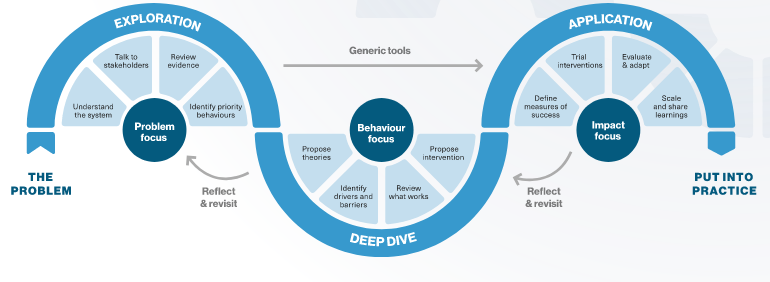Framework 169 Changing Behaviours (using the BehaviourWorks framework
Introduction
This is used to better understand and influence human behaviour; it involves unpacking problems, prioritising and understand behaviours and then trialling interventions to help change behaviours.

(source: BehaviourWorks Australia, 2021)
The above framework is divided into 3 phases, ie exploration, deep dive and application
1. Exploration - this involves building a shared understanding before implement change, ie defining and unpacking the problem
(source: BehaviourWorks Australia, 2021)
- understanding the system (using techniques, processes, etc to help understand the problem and identify the individuals, groups and organisations involved in understanding the problem so that they are part of the solution
"...as a society, we are dealing with increasingly complex problems and work environments where there are many competing agendas..."
BehaviourWorks Australia, 2021)
- stakeholder consultation (using a range of engagement tools such as interviews, workshops, panels, focus groups, etc to engage key stakeholders and understand their perspectives plus minumising 'missing links'
"...without their input and perspectives, the best laid plans can go awry. Genuine consultation challenges assumptions and provides insights that data collection may not capture..."
BehaviourWorks Australia, 2021
For stakeholder engagement you need to tailor things to each stakeholders particular needs)
- review evidence (conduct literature reviews, seek available information, ie data mining, etc so that better understand what is known and unknown about the problem and the factors that contribute to it, ie explore patterns, correlations, trends, etc)
- identify priority behaviours (identify all behaviours that could impact the problem and then prioritise the ones that will have the maximum impact; base prioritise on it's potential impact on the problem and the likelihood of adoption by relevant stakeholders; explore existing penetration levels, the cost of compliance and the barriers to adoption)
NB Need to understand who has to do what differently.
2. Deep Dive - this explores the context, barriers and motivation behind the prioritised behaviours, ie how do key stakeholders interact with each other; need to understand what drivers and barriers that influence behaviour; need to be aware of using unsuitable, assumed models of behaviour
"...by exploring the context, barriers and motivations behind behaviour - and what has worked (or not) in the past to change them - you can develop more effective interventions..."
BehaviourWorks Australia, 2021

- proposed theories (understanding influences on people's reactions and behaviours, ie why they do or don't engage
"...there are many models of behaviour drawn from a wide range of disciplines and traditions. Your job is to consider these models, understand which is relevant to the behaviour under consideration and agree on a theory to guide investigations moving forward..."
BehaviourWorks Australia, 2021)
- drivers and barriers (identify drivers and barriers to changing behaviours; need to explore
"...What really matters to them and what it's like to change their behaviours..."
BehaviourWorks Australia, 2021
This includes understanding the impact of unconscious biases, social norms, etc
"...Need to draw on observations, population data and other evidence to capture the full suite of influences impacting the behaviours of interest..."
BehaviourWorks Australia, 2021)
- evidence review (scan the literature to find what has worked, or not worked, elsewhere to promote similar behaviours)
- proposed intervention (develop and co-design an intervention strategy based on your knowledge and insights of the target audience and information gained during the exploration and deep dive phases; need to determine how to resource the intervention)
NB You can bypass a deep dive by using generic behaviour change tools to speed up the process.
"...sometimes you have enough evidence on the behaviour and target audience to move directly from exploration to application (intervention). Alternatively, your timelines and resources might be limited..."
BehaviourWorks Australia, 2021
3. Application - what impact have you made (this involves implementing, measuring, monitoring and evaluating, etc what's happening to the targeted behaviours)
- define measures of success (determine the key indicators and data collection that can be used to measure success, ie determine what type of data should be collected, how often, by whom, etc; should include measuring the underlying influences on behaviour and whether your intervention was implemented as planned)
- trial intervention (as no guarantee that intervention will be successful, need to conduct trial runs on sample groups to observe and evaluate impact so that can determine opportunities for modifications to improve;
"...these trials offered challenge your own assumptions and reveal important insights that allow you to refine - or redesign - the programme to maximise its impact..."
BehaviourWorks Australia, 2021)
- evaluate and adapt (have a robust monitoring and evaluating framework to determine the impact and areas that need modification; start documenting learning, ie both successes and failures, as you go along)
- scale and share learnings (based on the trial intervention plus findings for monitoring and evaluating, scale up the project or make the appropriate modifications; share documented learnings with relevant stakeholders.)
